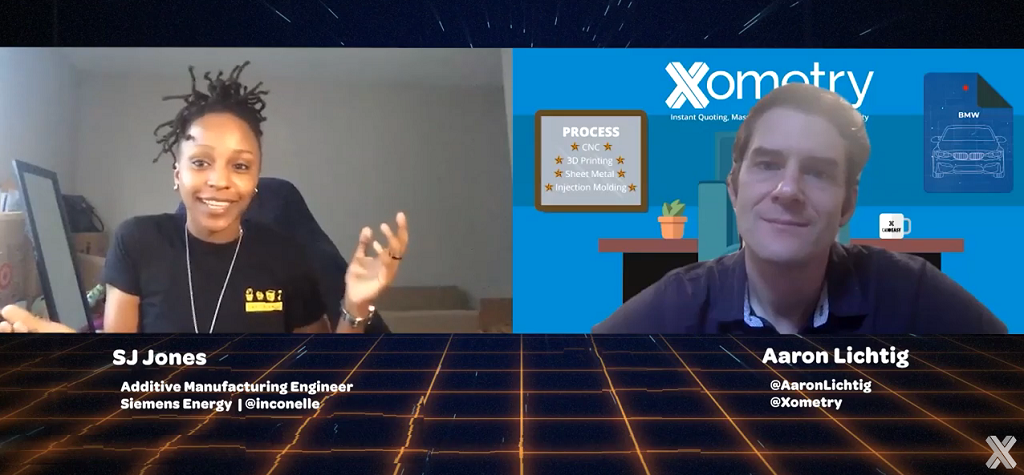
If you watch only one episode of Ok Xoomer, make it this one.
Xometry launched Ok Xoomer, an interview series of “Zoom chats with creative engineers and more”, earlier this year to facilitate conversations while it’s difficult-to-impossible to do so in-person. I had the opportunity to be host Aaron Lichtig’s first guest, and enjoyed a fun chat discussing the future of the 3D printing industry.
The series has continued over the last five months, and Aaron has now released conversations with 42(!) ace individuals.
The latest of these is additive manufacturing engineer SJ Jones, introduced as:
“In this episode of Ok Xoomer — Zoom chats with creative engineers and more — Aaron Lichtig, Xometry guy and former Jeopardy! champion, chats with SJ Jones, Additive Manufacturing Engineer at Siemens Energy, about pushing the limits of metal additive manufacturing, getting women involved in 3D printing, and the intoxicating smell of aluminum in the morning.
About our guest
SJ Jones is an additive manufacturing applications engineer from Orlando, FL currently working at Siemens Energy providing additive manufacturing solutions to the energy industry. She works with engineering teams on making metal additive parts to help create a decarbonized world. Most of those parts are aero-derivate and tend to be gas and steam turbine engine components. Outside of work, she’s a part-time, struggling grad student pursuing my second Master’s in Systems Engineering at the University of Central Florida and an active volunteer with the Oceania chapter of Women in 3D Printing which is working to close the gender-gap in additive manufacturing.SJ loves the smell of aluminum when walking onto the shop floor every morning and the favorite part of her job is to print demo parts and push the limits of engineering design for additive manufacturing.”
And the actual interview — clocking in at a highly-watchable 13 minutes:
Have The Conversation
Much of the interview is what we might expect as somewhat par for the course: how did you get into additive manufacturing, what do you do — the types of questions it’s always great to hear, to gain both background and inspiration.
Then it moves into trickier territory.
Aaron: “You had asked me before this session to ask you, what is the question nobody is asking?”
SJ: “The question nobody is asking is what is it like to be Black in AM? What is it like to be Black in additive?”
It’s like being a unicorn, SJ begins. But it’s no fairytale.
SJ meets at the intersection of several underrepresented groups in additive manufacturing today, she notes: she’s Black, she’s gay, she’s a woman.
If you don’t think these things matter — it’s about the work, right? It’s an increasingly automated advanced manufacturing sector, so it doesn’t matter who’s doing the work, right? — keep listening.
SJ recalls a brief story that’s all-too-familiar for the underrepresented in industry. In short, when delivering an expensive and advanced 3D printed part to a heat treat supplier, she was challenged upon arrival, asked for ID, and then assumed to be an Uber driver. SJ is an engineer working on her second Master’s degree.
“Wow, even in this industry, things like this still happen,” SJ says of her response.
Those things do still happen. Engineers may not always look how you expect them to look; the same can be said of executives, of materials scientists, of researchers, of receptionists.
After all, as SJ also says in the interview, “Sameness breeds sameness.” A major part of additive manufacturing — which SJ also compares to “magic” when she first encountered it — is thinking differently. What use is it to all group together with those with similar backgrounds, similar educational experiences and training, and ultimately similar ways of conceiving of both the world and design and manufacturing when the entire point of additive manufacturing, of concepts like DfAM, is to think differently?
And so we need to talk about diversity and inclusion.
Or, rather, keep talking about it. We need to have these conversations.
For more discussion on these topics, I’d like to offer some resources:
- Wi3DP 2020 Special Edition Diversity for Additive Manufacturing report
- 3D Printing Companies Standing For Equity
- This Is No Time To Stay Silent: Fabbaloo’s public statement
Ask the questions no one is asking. More importantly: listen to what your BIPOC colleagues tell you about their experiences. Let’s make this industry better.
